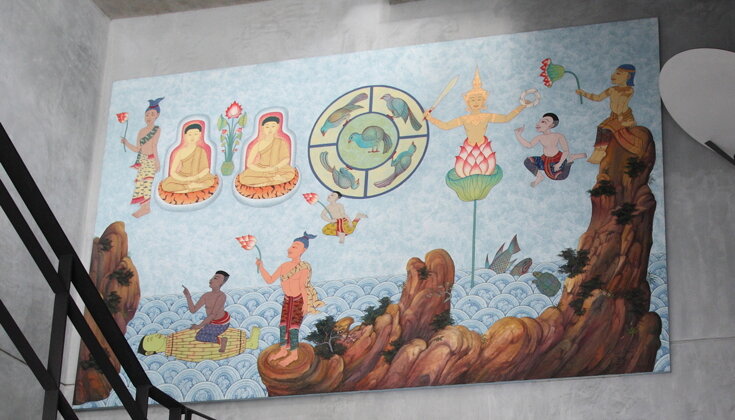Origin of Wisdom
Gather for the Buddha’s first teaching
Chased down to the riverbank by five murderous attackers, a man has jumped onto a bloated rotting corpse floating in the water and is paddling with his hands and feet towards the other shore. Symbolically, he is trying to escape from the cruel cycle of rebirth to reach the extinction of suffering, or Nibbana in Pali.
The five attackers are depicted as five birds flying in a circle after the man. These birds symbolize the never-ending suffering caused by the Five Aggregates of Clinging: corporeality or physical existence of a person or being; feeling or sensation; perception or recognition; mental formations such as volition, thoughts, fabrications and reactions; and consciousness.
The rotten floating corpse represents one’s physical body and its quality of loathsomeness and dirtiness—it needs constant bathing and cleaning. But however foul and disgusting it may be, the body is not worthless. If used wisely and properly, it can serve as a vehicle for breaking free from suffering and attaining Nibbana. The proper way to treat the body is to take the Middle Path between the two extremes of self-indulgence and self-torment.
The lotus represents wisdom. In this picture, many types of people are associated with the lotus, indicating that they all have wisdom. On the left side of the painting, these include the hermit, the man, and the little child, each holding a lotus, as well as the two monks sitting beside a vase of lotuses. These images signify that whoever can optimize the use of their body through the right study and practice of Dhamma can thereby cultivate their wisdom to eventually attain Nibbana.
A vigorous man is emerging from the largest lotus in the painting. This shows how wisdom can arise from a filthy body, just as a beautiful lotus can spring from dirty mud underneath the water. The brave man’s sword and discus represent the sharpness and strength of wisdom, which can cut through and destroy defilements, the cause of suffering.
The little child who is moving toward the brave, vigorous man holding weapons represents ignorance and delusion which makes one blind to the nature of the mind. Ignorance gives rise to defilements and suffering, and must be eliminated by wisdom. In order to completely eradicate defilements, one must first be clearly aware of one’s own ignorance. Through ignorance, one is misled to cling to the sense of ‘I’, ‘me,’ and ‘mine,’ and this leads to suffering. When the cause of suffering is clearly identified, one can develop Right View and wisdom to rid oneself of ignorance and finally put an end to suffering.



